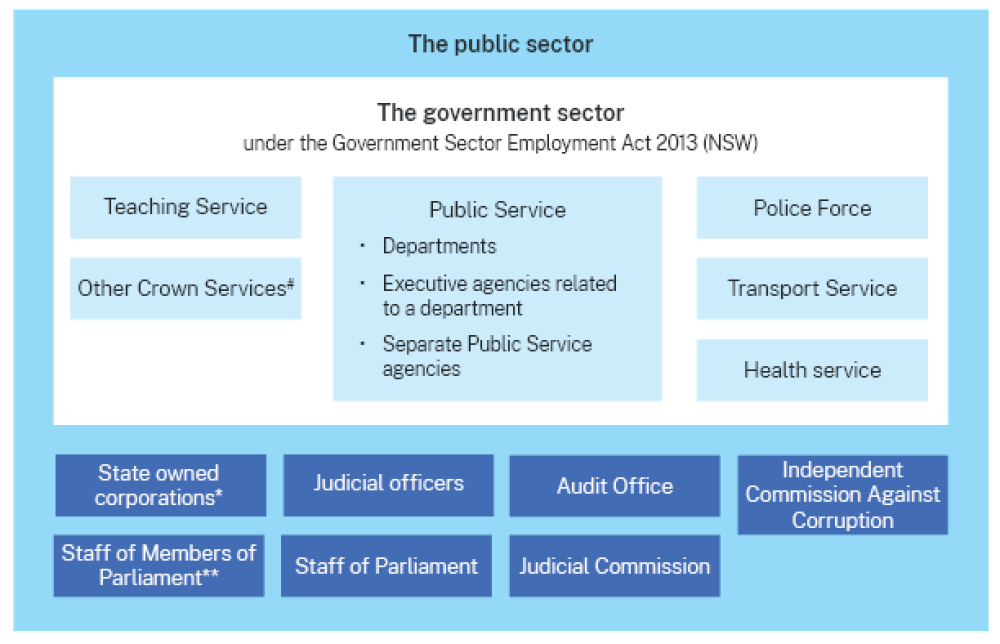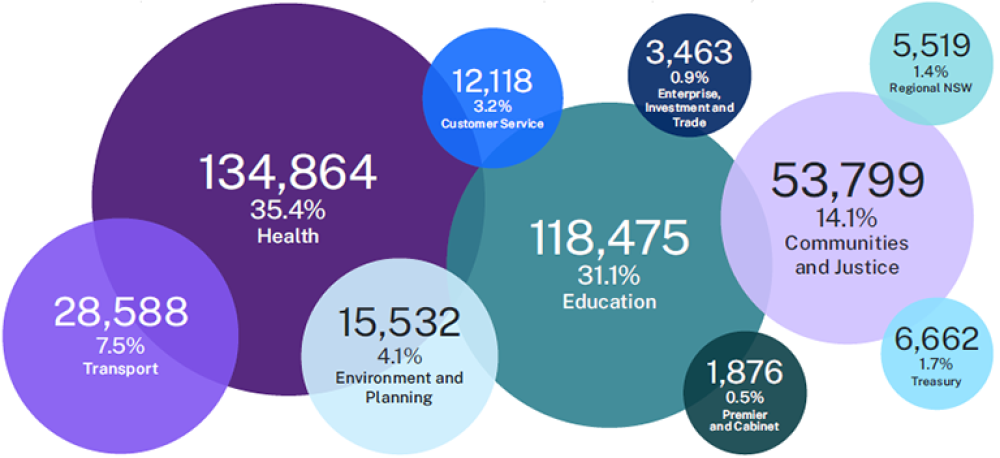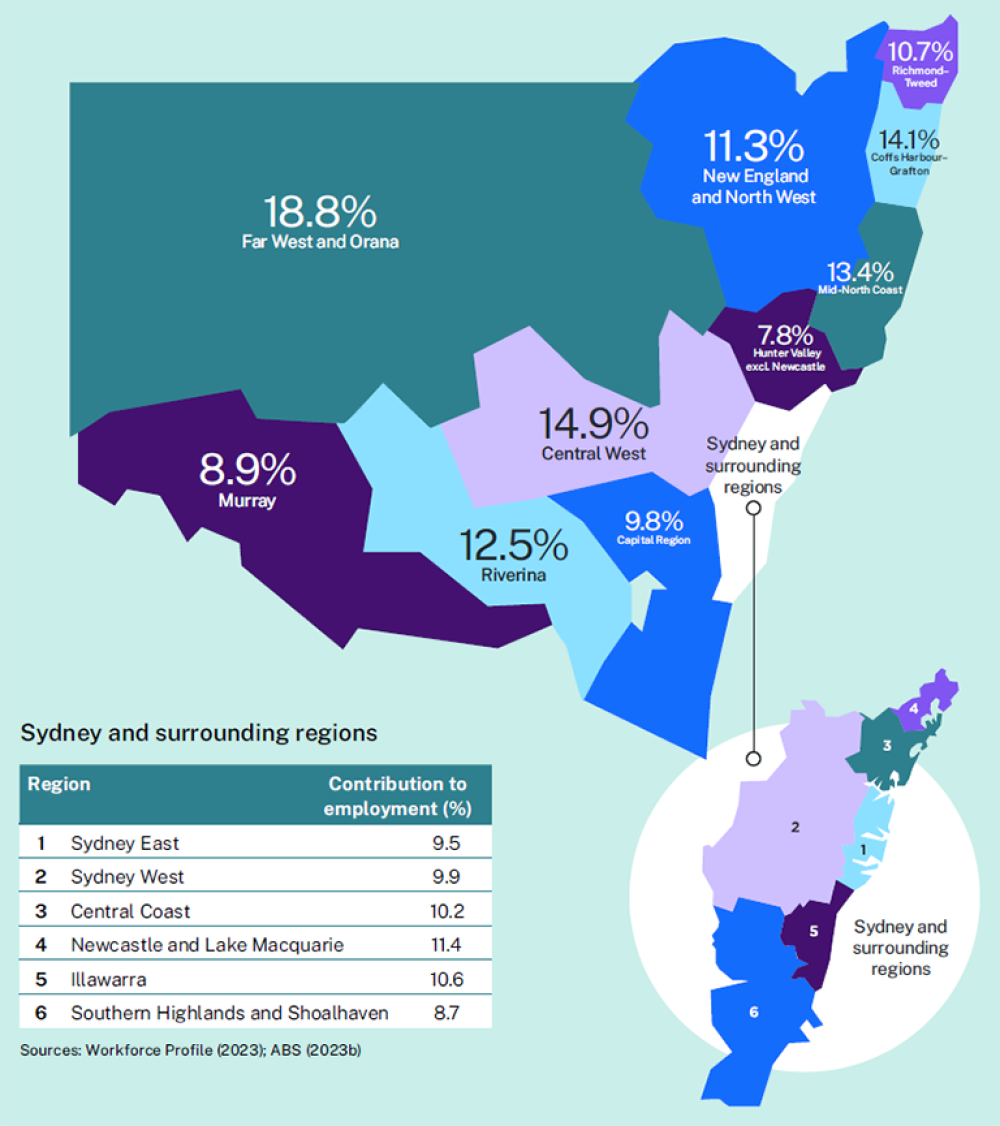Over 450,000 employees work in the NSW public sector to deliver a wide range of services to the people of NSW. Departments and agencies in the public sector are arranged into 11 groups or portfolios. Each portfolio coordinates related day-to-day public services and is led by a secretary. The term ‘portfolio’ is commonly used for administrative purposes; however, portfolios are not established by legislation.
Due to machinery of government changes, there have been some changes in the way government functions and responsibilities are allocated and structured across government agencies.
Headcount and full-time equivalent employees
453,210
ongoing, temporary and casual employees
equating to 381,272
full-time equivalent employees
Source: Workforce Profile (2023), census period
The number of full-time equivalent (FTE) employees in the sector increased by 17,265 (or 4.7%) from 2022 to 2023. This is the largest recorded growth in the workforce since the Workforce Profile commenced in 1999. Key occupations with notable increases in FTE were Clerical and Administrative Workers (+3,274 or 6.7%), School Support Staff (+2,324 or 8.9%), Nurses (+1,538 or 3.0%), School Teachers (+611 or 0.9%), Prison Officers (+553 or 13.9%), Ambulance Officers (+538 or 10.4%) and Medical Practitioners (+339 or 2.5%).
Source: Workforce Profle (2014–23), census period
The number of people (headcount) employed in the sector increased by 4.0% in 2023, outpacing the growth in the number of people employed in NSW overall, at 3.3%.
Source: Workforce Profle (2019–23), ABS (2023a)
Structure of the NSW public sector
The GSE Act establishes 2 main employment groups: the government sector and the Public Service within it. Most government employees are in the government sector.
The government sector is structured into 11 portfolios that coordinate related day-to-day public services, each led by a secretary.

The public sector covers the government sector (under the Government Sector Employment Act 2013 (NSW) (GSE Act), which includes six areas: the Teaching Service, Other Crown services#, the Public Service (including departments, executive agencies related to departments and separate Public Service agencies), the Police Force, the Transport Service and the Health Service.
Also under the umbrella of the public sector, but outside the government sector, are seven areas: State owned corporations*, Staff of Members of Parliament**, Judicial officers, Staff of the Parliament, the Independent Commission Against Corruption, the Judicial Commission and the Audit Office.
# Examples of other Crown services include the TAFE Commission, School Administrative and Support Staff, and Sydney Trains.
* Under the GSE Act, State owned corporations are included in the government sector for certain specified purposes. However, in this report, they are treated as part of the public sector, not as part of the government sector.
** The PSC does not collect data on these employees.
Note: Under the GSE Act, NSW universities are part of the government sector for certain specified purposes. The PSC does not collect data on the employees of NSW universities. They are not considered part of the public sector or government sector in this report.
Full-time equivalent employees by portfolio

| Cluster | FTE | % |
|---|---|---|
| Health | 134,864 | 35.4 |
| Education | 118,475 | 31.1 |
| Communities and Justice | 53,799 | 14.1 |
| Transport | 28,588 | 7.5 |
| Environment and Planning | 15,532 | 4.1 |
| Customer Service | 12,118 | 3.2 |
| Regional NSW | 5,519 | 1.4 |
| Enterprise, Investment and Trade | 3,463 | 0.9 |
| Premier and Cabinet | 1,876 | 0.5 |
| Treasury | 6,662 | 1.7 |
Source: Workforce Profile (2023), census period
Note: Percentages indicate the contribution of the portfolio’s FTE to the public sector’s total FTE.
The FTE breakdown is based on the structure that was in place before 1 July 2023. Since then, the Department of Premier and Cabinet has been separated into 2 separate agencies: the Cabinet Office and the Premier’s Department.
From 1 January 2024, the Department of Planning and Environment will be split into 2 new departments: the Department of Climate Change, Energy, the Environment and Water; and the Department of Planning, Housing and Infrastructure.
Headcount and contribution to overall employment by NSW region
The NSW Government is a significant employer in every part of the state. A high proportion of public sector employees work in Sydney (59.3%). However, the sector contributes more to overall employment in regional areas of NSW than it does to employment in Sydney.
In 2023, 65.9% of public sector employees worked in a metropolitan area (Sydney, Newcastle or Wollongong), while 34.0% worked in regional NSW. Of the NSW Estimated Resident Population,
62.7% worked in a metropolitan area, while 37.3% worked in regional NSW. The NSW Government is a significant contributor to regional employment. In recent years, the government has succeeded in increasing the number of regionally based public sector employees, including at the senior executive level.

Greater NSW
| Region | Contribution to employment (%) |
|---|---|
| Hunter Valley excl. Newcastle | 7.8 |
| Mid-North Coast | 13.4 |
| New England and North West | 11.3 |
| Far West and Orana | 18.8 |
| Coffs Harbour – Grafton | 14.1 |
| Richmond – Tweed | 10.7 |
| Capital Region | 9.8 |
| Riverina | 12.5 |
| Murray | 8.9 |
| Central West | 14.9 |
Sydney region
| Region | Contribution to employment (%) |
|---|---|
| Sydney East | 9.5 |
| Sydney West | 9.9 |
| Central Coast | 10.2 |
| Newcastle and Lake Macquarie | 11.4 |
| Illawarra | 10.6 |
| Southern Highlands and Shoalhaven | 8.7 |
Sources: Workforce Profile (2023); ABS (2023b)
Occupations
The NSW public sector employs people in a wide range of occupations.
70,442 School Teachers
up from 69,830 in 2022
53,417 Nurses
up from 51,880 in 2022
16,286 Police Officers
down from 17,033 in 2022
52,188 Clerical and Administrative Workers
up from 48,914 in 2022
28,585 School Support Staff
up from 26,261 in 2022
14,013 Medical Practitioners
up from 13,674 in 2022
7,923 Social and Welfare Professionals
up from 7,834 in 2022
5,253 Cleaners and Laundry Workers
up from 5,151 in 2022
5,702 Ambulance Officers
up from 5,164 in 2022
4,314 Labourers
up from 4,246 in 2022
4,520 Prison Officers
up from 3,967 in 2022
4,208 Firefighters
down from 4,252 in 2022
2,168 Train Drivers
down from 2,217 in 2022
2,069 Food Prepatation Assistants
up from 1,983 in 2022
Source: Workforce Profile (2022, 2023), census period
Employment types
The type of employment that the NSW public sector offers varies to ensure the sector can flexibly deliver services; however, most employees are employed on an ongoing basis. The numbers of all employment types have stabilised over the past 2 years. The wide variety of roles within the NSW public sector means that our people are employed across a wide remuneration range.
Source: Workforce Profile (2014–23), census period
Note: ‘Other’ includes employees whose employment category is Contract Executive, Contract Non-Executive, Statutory Appointee, Transport Senior Manager or anything not classed as Ongoing, Temporary or Casual.
Source: Workforce Profile (2014, 2019, 2023), census period, non-casual only
Note: To provide a whole-of-sector perspective, remuneration has been aligned with the non-executive grades defined in the Crown Employees (Administrative and Clerical Officers – Salaries) Award 2023. The GSE Act allows the relevant minister to determine the bands under which senior executives are employed. Currently, there are 4 bands.
- Next section: Our people
Who we are and how we feel at work.